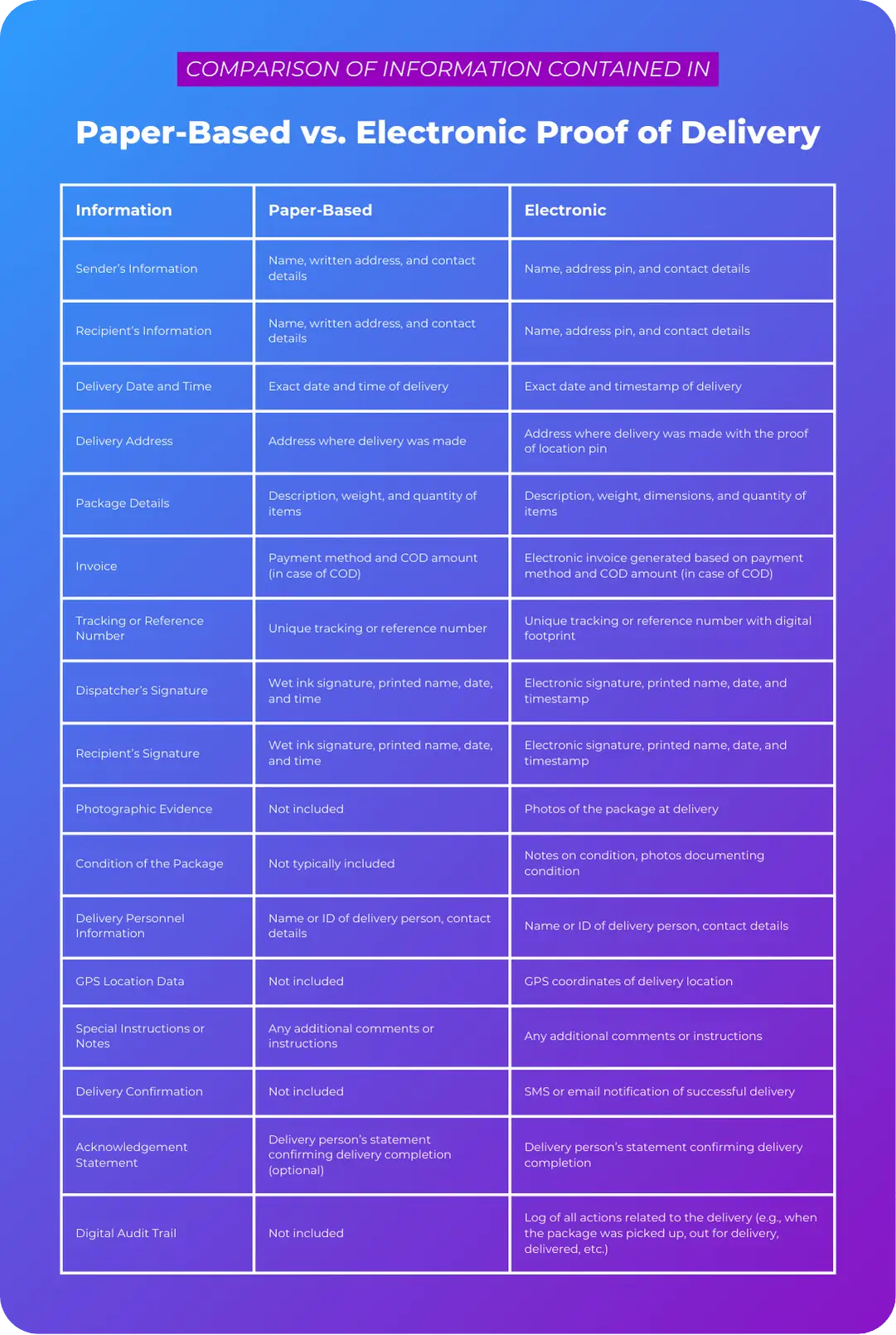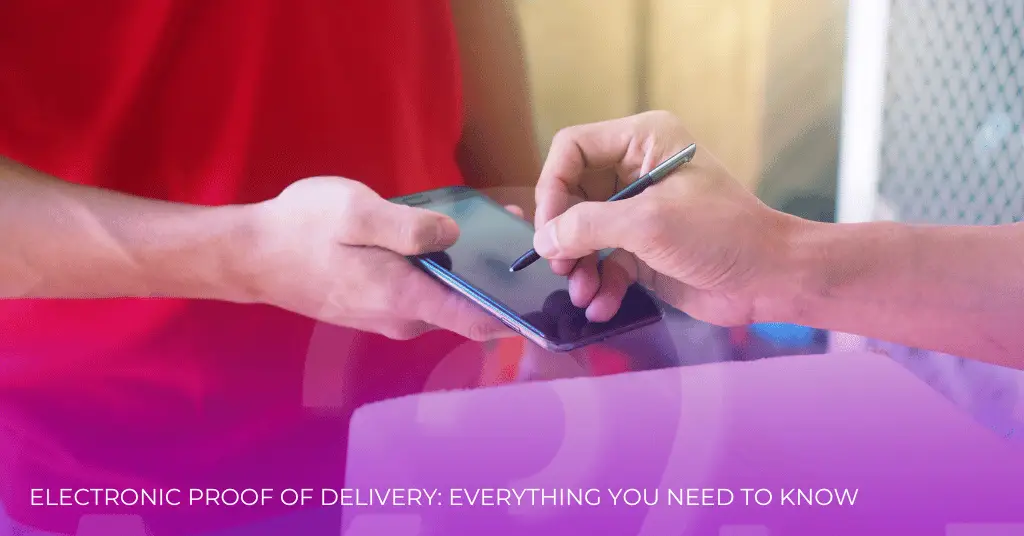Electronic proof of delivery is a digital document that proves the successful completion of a delivery. Read on to find out how it works.
Well, in a perfect world, you’d want your deliveries to operate on autopilot without having to keep track of their status minute by minute. Sadly, that’s not the case, and you might find yourself struggling to appease customers claiming that their package was never delivered, that it arrived damaged, or that the delivery person left it at the wrong location.
And if you don’t have evidence to prove that the package was delivered at the stipulated location and in pristine condition, it’s just the customer’s word against yours. To salvage the situation, you might also consider offering a refund to said customer besides arranging for a redelivery of the “lost” package.
But hey, we’ve got good news for you: a proof of delivery can protect you from customer disputes and financial losses you have to bear unwillingly due to seemingly unfulfilled orders.
As the name suggests, a proof of delivery is a confirmation that proves the delivery of a package in the right condition to the right person at the right location.
Types of Proof of Delivery
A proof of delivery can be both digital and paper.
Paper-Based
This is usually in the form of a physical document or receipt and requires traditional wet ink signatures for validation at every step of the delivery cycle. For example, when dispatching an order, the dispatcher signs the proof of delivery, and the recipient signs it upon receipt.
Paper proofs of delivery require a lot of human intervention, are prone to damage or loss, and can lead to mistakes in data entry. But despite their numerous drawbacks, paper documents continue to find widespread use today. Not to forget, unlimited use of paper is hazardous to the environment as well.
Electronic Proof of Delivery
This involves using digital technology like a quick response (QR) code, photos, and electronic signatures to mark a delivery as complete. All top delivery management softwares now offer multiple electronic proof of delivery, as it is more accurate, secure and environmentally-friendly.

Is Proof of Delivery Different from the Freight Bill of Lading?
Proof of delivery and the bill of lading are two essential documents in logistics, but they serve different purposes.
A bill of lading is used at the early stages of the supply chain to draft agreements between shippers and carriers. It is more detailed than a typical proof of delivery document and provides additional information, including a description of the goods being transported and the purchase order number.
Also, unlike proof of delivery, a bill of lading is a legally binding contract in that it outlines the terms and conditions of the shipment. It also serves as a shipment receipt and is signed by an authorized representative of the shipping company when the carrier delivers the shipment to a warehouse or fulfillment center. In contrast, a proof of delivery is commonly used in last-mile delivery, where a package is handed over to the customer.
To put it simply, proof of delivery and the freight bill of lading are both equally important because they help track shipments and packages and safeguard liability. However, they are not identical and, therefore, cannot be used interchangeably.
Key Benefits of Electronic Proof of Delivery
Packages Don’t Go Missing Anymore
Lost or stolen packages are a major pain point for delivery operations. Paper documents often result in extensive paper trails that make storing and retrieving paper-based proof of delivery cumbersome and less efficient. They also use large amounts of paper, which costs companies money—and a lot of it.
Electronic proof of delivery saves you a lot of this hassle. The combination of ease of use, customizable proof of delivery templates, photo uploads, and built-in electronic signature capture streamlines the proof of delivery creation and signing process. Mile and other delivery management systems incorporate a tool for converting handwritten signatures from jpg or jpeg to png, which changes an image into a transparent e-signature, ready for uploading onto the digital proof of delivery document.
When a photo or e-signature is required to authenticate delivery, there is less chance of damaged or stolen packages, incorrect addresses, or incorrect signatures.
Partial or Wrong Deliveries Are No Longer a Headache
Another reason electronic proof of delivery is replacing its paper counterpart is that it resolves the problem of partially or incorrectly delivered orders seamlessly. It can take hours or days to physically relay information about packages that were delivered with a few items wrong or missing. In the best-case scenario, you can send a runner to submit the paper proof of delivery to the dispatcher at the fulfillment center the same day. But with an electronic proof of delivery, it reaches them almost instantly via a delivery management app, which they use to check the delivery status of each and every order they send out on a given day.
Customers Are Confident About Your Services
As it is, late deliveries lead to customer dissatisfaction. Customers are even angrier when the package they receive is wrong, incomplete, or damaged. Unlike physical signatures, which are vulnerable to forgery, e-signatures are impossible to tamper with. Moreover, the electronic proof of delivery includes detailed audit trails of when a package was picked up, where it was delivered, and who received it. It also records and timestamps any changes or modifications made to the delivery process before the package was delivered.
The unlimited photo upload option further limits any chance of fraudulent behaviour. For instance, a delivery driver can take a picture of the delivered items and the exact location where he left them. With the app’s automatic timestamp and upload feature, the customer’s order details are readily available in one convenient location. Even if they aren’t there to receive the delivery in person, the customers can rest easy knowing their packages have arrived safely when they see photo proof of delivery.
This increased accuracy and transparency build customer trust and confidence in your offerings. Plus, given the increasing customer preference for contactless delivery, an electronic proof of delivery, be it via photos, e-signatures, or both, offers a level of peace of mind that paper receipts can never provide.
Delivery businesses, too, can handle refunds and returns caused by late, damaged, or incorrect deliveries more efficiently with an electronic proof of delivery system. Compared to paper receipts, which can be manipulated and doctored fairly easily, electronic proof of delivery gives you the complete and 100% accurate evidence you need to verify refund requests.
How Does Electronic Proof of Delivery Work?
There are typically two parts to the standard electronic proof of delivery feature:
- A driver app that allows users to access and collect delivery-related data while on the go
- A centralized dashboard that enables the back office to monitor field operations
Delivery drivers use their iOS or Android-powered phones and tablets to log deliveries and gather other operational data as needed. The central hub receives and stores all collected field data, including customer device and location data, for predictive analytics.
Teams in the office can view field conditions in real time, monitor a driver’s behavior during his trips, and update route maps according to changes in delivery volume or unexpected traffic situations from the dashboard, which is accessible through a web browser.
Customers are also able to monitor the status of their orders and receive delivery updates. As soon as a delivery driver picks up their package, the system sends an alert to the customer saying that the driver is on his way. It also notifies them when the delivery is complete. Since everything can be traced back to the source, it becomes easier for the back office to identify a potential issue and resolve it proactively.
Wrapping Up
Electronic proof of delivery is not only more efficient and seamless; it also eliminates the need for printing or physical archiving, as every step can be completed digitally and stored in the cloud for quick access. The best part is that you don’t have to have a separate software for it. If you use an all-inclusive delivery management software like Mile, you can put this feature into action immediately and say goodbye to any future claims from customers that their package never arrived.
Do you wish to spend more time focusing on scaling your delivery business and less time responding to consumer complaints? Let’s connect.


